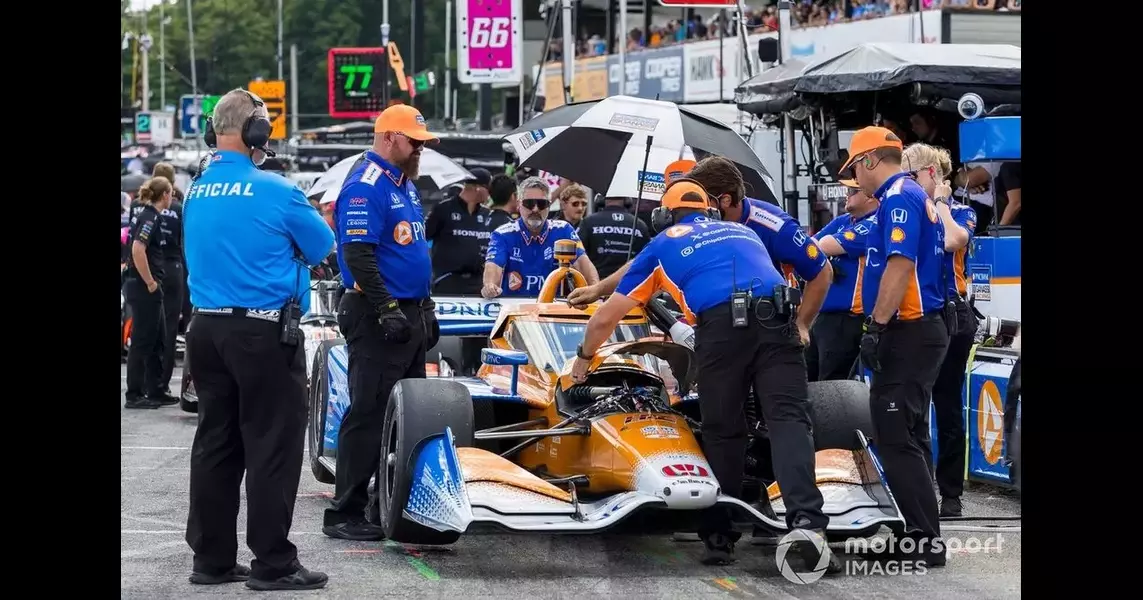Dixon’s IndyCar hybrid failure “could have happened to a lot of cars”

Hybrid Hiccup: IndyCar's Unexpected Power Struggle
Scott Dixon, the veteran IndyCar driver, faced a surprising setback at the Mid-Ohio race when his Chip Ganassi Racing car's hybrid system caused his engine to shut down. While a frustrating experience, Dixon's candid assessment of the issue suggests it could have impacted other cars on the grid, raising questions about the reliability and integration of the new hybrid technology in the series.Powering Through the Challenges of Hybrid Integration
A Sudden Shutdown and Its Aftermath
Scott Dixon, the seven-time IndyCar champion, was poised for a strong performance at the Mid-Ohio race, but his hopes were dashed when his car's hybrid system experienced a malfunction. Dixon's car came to a halt on the out-lap, forcing him to rejoin the race over 20 laps behind the leaders. This setback saw him tumble from second in the championship standings to fourth, now 71 points behind his teammate, Alex Palou.In the aftermath, Dixon revealed that the low-voltage electrical system in his car "just did a runaway" and shut down the power unit. The hybrid system, which is designed to provide a boost of power, had entered a parameter that it didn't like, causing it to turn off the engine, which was the only way to charge the capacitor. This unexpected behavior left Dixon and his team scrambling to fix the issue and get the car back on track.
Despite the frustration, Dixon acknowledged that the problem "could have happened to a lot of cars" on the grid, suggesting that the integration of the hybrid technology is still a work in progress. He noted that the teams and manufacturers have been given some flexibility in how they manage the regenerative braking and power deployment, and his car may have been "slightly different" in its settings, leading to the unexpected shutdown.
The Hybrid Debut on the Ovals
The hybrid system will make its oval debut this weekend at Iowa, and while it will provide a boost of power, Dixon believes it may not have as significant an impact as it does on road courses. The Iowa oval is a "low power-dependent circuit," meaning the amount of energy the hybrid system can provide may not be as crucial as it is on tighter, more technical tracks.Scott McLaughlin, the Team Penske driver, echoed Dixon's sentiment, stating that the hybrid system is "probably not as useful on an oval as it is on a road course." However, McLaughlin acknowledged that the hybrid technology will still be utilized in qualifying and during the race, providing an additional tool for drivers to manage their performance.
The integration of hybrid technology in IndyCar is a significant step forward for the series, but as Dixon's experience at Mid-Ohio has shown, there are still challenges to be overcome. The teams and manufacturers will need to continue to refine the systems and find the optimal settings to ensure reliability and consistent performance across the diverse range of circuits on the IndyCar calendar.
The Hybrid Advantage: Balancing Power and Efficiency
The introduction of hybrid technology in IndyCar has been a highly anticipated development, promising to add an extra layer of strategy and excitement to the racing. The 60bhp boost provided by the hybrid system can give drivers a crucial advantage, especially on road and street courses where the ability to deploy power effectively can make the difference between victory and defeat.However, as Dixon's experience has highlighted, the integration of these complex systems is not without its challenges. The delicate balance between power and efficiency, the need to manage regenerative braking, and the potential for unexpected issues all require careful consideration and ongoing refinement by the teams and manufacturers.
As the series heads to the ovals, where the hybrid system may not provide as significant a performance boost, the focus will shift to how drivers and teams can leverage the technology to their advantage. Whether it's in qualifying, where a well-timed hybrid deployment could secure a crucial pole position, or during the race, where strategic use of the hybrid boost could help drivers make crucial passes, the hybrid system will continue to be a crucial element of the IndyCar landscape.
The Future of Hybrid in IndyCar: Embracing Innovation and Reliability
The introduction of hybrid technology in IndyCar is a significant step forward for the series, aligning it with broader trends in the automotive industry and showcasing the sport's commitment to innovation and sustainability. As the teams and manufacturers continue to refine the systems, the goal will be to strike a balance between the performance advantages of the hybrid boost and the reliability required to ensure a fair and competitive championship.Dixon's experience at Mid-Ohio serves as a reminder that the integration of new technology is not without its challenges, but it also highlights the resilience and adaptability of the IndyCar community. The series and its stakeholders will need to work closely to address any issues that arise, ensuring that the hybrid system becomes a seamless and reliable part of the racing experience.
As the IndyCar season progresses, the hybrid system's impact on the championship battle will continue to be a topic of intense interest and discussion. Fans and observers will be eager to see how the teams and drivers navigate the complexities of this new technology, and whether it ultimately enhances the excitement and unpredictability that has long been a hallmark of IndyCar racing.